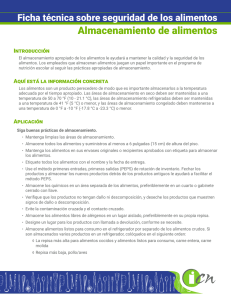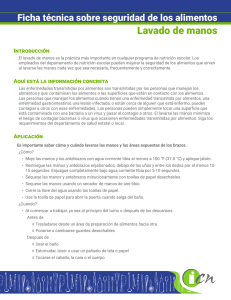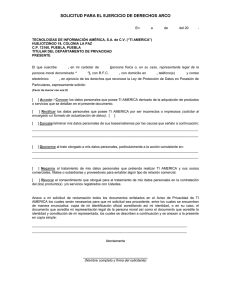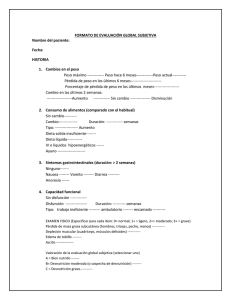Iniciativa hacia la Erradicación de la Desnutrición Infantil en Latino
Anuncio
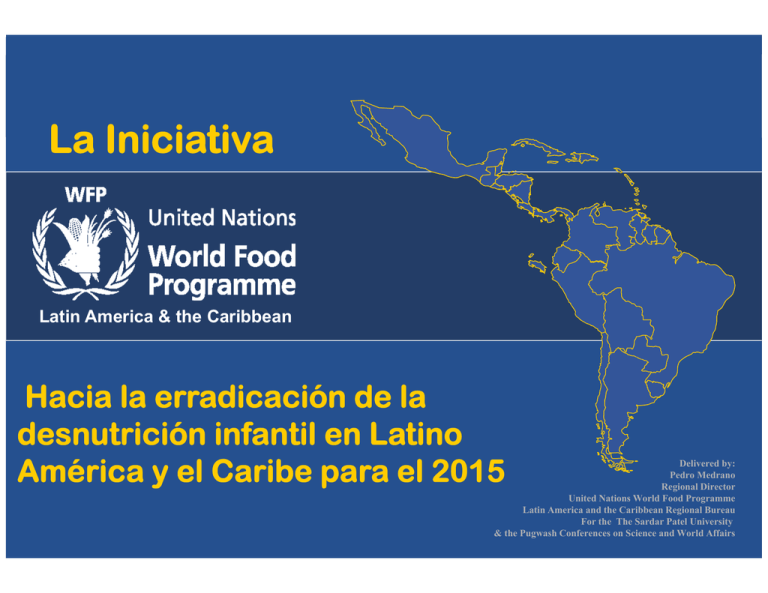
La Iniciativa Latin America & the Caribbean Hacia la erradicación de la desnutrición infantil en Latino América y el Caribe para el 2015 Delivered by: Pedro Medrano Regional Director United Nations World Food Programme Latin America and the Caribbean Regional Bureau For the The Sardar Patel University & the Pugwash Conferences on Science and World Affairs 1. Un pequeño progreso en el logro de las metas del milenio. 2. Desigualdades en contra de la cohesión social; indígenas y descendientes africanos. 3. Hambre y desnutrición: causas y consecuencias. 4. Las emergencias conspiran contra los más vulnerables. 5. El costo de la desnutrición: una base para comenzar 6. La iniciativa de erradicar la desnutrición infantil en América Latina. 7. Puede hacerse y debe hacerse. Latin America: Poverty and Indigence, 1990 - 2006 (Millions of People) Entre el 2002 y el 2005, la población pobre e indigente disminuyó 12 y 16 millones respectivamente. Sin embargo, el número absoluto de población pobre permanece demasiado alto. 250 Million 200 150 200 204 211 221 217 209 205 93 89 89 97 88 81 79 1990 1997 1999 2004 2005 2006 136 100 62 50 0 1980 Indigents Source: ECLAC 2002 Non-indigent poor Latino America: promedios de pobreza y GPD per cápita. 1980 - 2006 Promedios de pobreza en la Región han bajado a los niveles de los primeros años de los 80, pero con un 17% más alto del rango de ingreso per cápita más alto. 49 1990 Percentage of poor population 48 1990 47 46 1994 45 44 2002 1986 43 42 41 40 39 38 3200 1980 3400 1997 2001 2000 2004 1980 2005 3600 3800 4000 Per capita GDP (US$ at 2000 prices) Source: ECLAC, on the basis of special tabulations of household surveys in the relevant countries. a/ Estimates for 19 countries of the region, including Haiti. b/ Projection. 2005 2006 b/ 4200 4400 Latino America (20 países): Nivel de expansión social per cápita entre 1990-1991, 1996-1997, y 2000-2003 (US$ en1997) 1800 1990-1991 1996-1997 2002-2003 1600 Gasto vs Inversion social 1400 U S$ per cápita 1200 1283 1071 1000 763 800 676 774 683 600 600 565 514 488 422 395 400 200 293 68 76 109 112 114 136 149 170 300 180 Source: ECLAC, Social development division, database on social expenditure. América Latina Argentina U ruguay C osta R ica C hile Panamá Brasil México Venezuela Trinidad y Tabago Jamaica C olombia R epública D ominicana Perú El Salvador Bolivia Paraguay H onduras Guatemala Ecuador N icaragua 0 Alcanzando el desarrollo de las metas del milenio en Latinoamérica y El Caribe Possibilities of Achieving the Target Objetivo #1 del Milenio Desarrollo – Erradicación de la extrema pobreza y el hambre. Target #2 Reducción a la mitad de la proporción de gente que sufre de hambre. Indicador 1 – Malnutrición global de los niños menores de cinco años ( peso y edad). Indicador 2 – % de población Undernourished Source:ECLAC. Panorama Social de América Latina 2002-2003. Ambos indicadores logrados. Al menos un indicador. No pudo adquirir ningún indicador. No analizado en el estudio. 1. Un pequeño avance hacia el desarrollo de las metas del Milenio. 2. Desigualdades en contra de la cohesión social; Indígenas y descendientes africanos. 3. Hambre y mala nutrición; causas y consecuencias. 4. Emergencias conspiran en contra de los más vulnerables. 5. El costo de la mala nutrición; A Baseline para comenzar. 6. La iniciativa para erradicar la baja nutrición de los niños NIños en Lac para el 20015??? Child In Lac By 2015 7.Puede hacerse; debe hacerse. GINI COEFFICENT Regiones del Mundo: GINI coeficiente, data circa ?? 2002 ( grado de inequidad en distribución del ingreso) 80 80 70 70 60 60 50 50 40 40 30 20 30 57.12 45.41 43.14 20 37.82 32.56 32.27 34.00 10 10 0 0 Sub-saharan Africa Gini South Asia East Asia & Pacific Highest Source : World Bank, World Development Indicators & ECLAC Middle East & North Africa Lowest Latin America and Eastern Europe & the Caribbean Central Asia Percentile 75 OECD Percentile 25 Inequidades en la Región LATIN AMERICA: HOUSEHOLD SHARES OF TOTAL INCOME, BY INCOME QUINTILE, around 2002 7 0 .0 35 Poorest quintil Richest Q./ Poorest Q. Aver. LA: 52.3 Aver. Caribbean: 44.6 Richest quintil Ave. LA: 4.3 Aver. Caribbean: 6.2 Bolivia Brazil Dominic.R Panama Colombia 0 Nicaragua 0 .0 Honduras 5 Paraguay 10 .0 El Salvador 10 Peru 2 0 .0 Costa Rica 15 Venezuela 3 0 .0 Chile 20 G uatemala 4 0 .0 Argentina 25 Ecuador 5 0 .0 Mexico 30 Uruguay 6 0 .0 Cap Haitien,Haiti. Haiti segundo más grande ciudad en el norte . 67 % de la población de esta ciudad puerto, la mayoría de ellos emigrantes desde la costa del país, viven en extrema pobreza. 2.4 millones de haitianos, casi un tercio de la población no tiene suficientes recursos para una canasta diaria de alimentos. Cerca del 65% de los niños ????bajo five face anemia??. WFP´s ayuda a la gente más vulnerable viviendo en ???overcrowded makeshift housing,?? con poca o nada sanidad y frecuentemente no suficiente comida para el mínimo requerimiento diario nutricional. WFP soportes ???sobre 800.000 personas más de la mitad de ellos son niños, cada año en Haití. WFP ha llegado a ser la agencia líder de apoyo del Programa Nacional del Gobierno Haitiano para la lucha en contra de los parásitos, proveyendo de medicina worming?? dos veces al año a más de 400.000 escuelas de niños a través del país. Anemia y desnutrición crónica en Latinoamérica y el Caribe Anemia (Hb<11g/dl) en niños menores de cinco años en LAC Stunting 65.8 Haití 2001 Height/Age -2SD, children under five in LAC 57.5 Ecuador 1996 56 Bolivia 1998 53.8 60 50 40 30 20 10 0 51.9 Paraguay 2000 48.2 Jamaica 1997 46.0 Cuba 2000 % 40.0 Honduras 1996 Uruguay 2000 36.1 Panamá 1999 36.0 33.2 Colombia 2005 28.4 Nicaragua 1993 27.8 Perú 1998 27.2 México 1999 26.0 Costa Rica 1996 G 25 Republica Dominicana 2000 29 26 26 ua 26.0 Guatemala 1995 49 22.4 Argentina 1995 18.9 El Salvador 1988 1.5 Chile 2004 0.0 10.0 20.0 30.0 40.0 50.0 60.0 23 20 19 18 16 te H o ma n d la ur a Bo s li E c v ia ua do r H Ni a ca it i E l ra g S a ua lv ad M or L A ex ic C Re o gi on Venezuela 1998 70.0 Pe rce ntaje (%) Promedios nacionales significan diferencias enla prevalencia de la malnutrición y profundos bolsillos de hambre al interior de los países. High prevalence of chronic malnutrition is closely associated with high concentrations of Afro-descendant and indigenous populations Source: UNICEF SOWC 2006 Source : DN: EMI Unicef 2005,Chile: MINSAL 2004,Colombia: ENSIN 2005 Anemia: Available Country Data Indígenas y de afro-descendientes afectados por desnutrición en Áreas Rurales Latino America (11 países): Desnutrición entre niños menores de cinco años por (etnias??)ethnicity (Porcentajes) 70.0 Indigenous 60.0 Non Indigenous Global Undernutrition Chronic Undernutrition 50.0 Belize % 40.0 30.0 Mexico 20.0 10.0 % Stunting?? En escuelas de niños 50.0 - 89.0 25.0 - 49.9 0.0-24.9 % Población Indígena 2001 % Población no indígena 2001 G uatem ala 1995 E c uador 1999 P erú 2000 B oliv ia 1998 b/ B ras il 1996 Trinidad y Tabago 1987 G uatem ala 1995 E c uador 1999 B oliv ia 1998 b/ P erú 2000 Trinidad y Tabago 1987 B ras il 1996 0.0 Guatemala Indigenas y Afro-descendientes en Areas Rurales Latin America (11 countries): Undernutrition among children under 5 years of age, by place of residence, around 1999 (Percentages) 55.0 50.0 Urban Undernutrition 45.0 Rural Chronic undernutrition 40.0 35.0 30.0 25.0 20.0 15.0 10.0 5.0 0.0 a gu ara 9 y1 90 ca ini m Do n 0 a2 02 a Br 1 sil 99 6 l iv Bo ia a 98 19 / ad cu o 9 r1 99 m ate al 9 a1 95 ag ab r T 9 o1 87 ua rag a P 5 0 9 8 99 00 99 99 1 2 1 1 a la ia or gu ma ad mb a e r u o t l a ca Ec Co Ni Gu 9 y1 90 E y Gu ad . d p i e in Source:REconomic Commission for Latin America and the Caribbean (ECLAC), on the basis of special tabulations of results from the Demographic and Health Tr P Surveys (DHS) conducted in the relevant countries. Desnutrición en ¿Middle income? países bajo ¿ Income países Undernourished (in millions) Sobre 45 millones de gente desnutrida viven en ¿ middle income ? países Medio Income países 30 26.7 25 Menos de siete millones de desnutridos viven en países de low income US$900 20 16.1 15 10 5.8 5 3.8 0 < $ 500 $ 500 - $ 2,000 $ 2,000 - $ 4,000 GDP/Capita Source: FAO-SOFI 2006 and ECLAC Panorama Social 2006 > $ 4,000 Desnutrición: una sentencia de muerte Latino America (10 países): Indígenas y no indígenas Rangos de Mortalidad Infantil (2000 Censo) Rangos de mortalidad infantil en LAC por causas asociadas a la malnutrition 345,648 a Año Paraguay Bolivia Ecuador Ha escuchado las noticias de hoy? Panamá uatemala México Honduras Indígenous Brasil Non-indígenous osta Rica Chile 0.0 10.0 20.0 30.0 40.0 50.0 60.0 70.0 80.0 1 MORE CHILD Desnutrición una amenaza vital Desnutrición crónica, el mejor indicador de la calidad de vida, es un signo de un problema estructural Nutridos Age= 17 Total IQ= 134 CC= 57.4 cm Z-CC= 1.64 VE = 1.592 cm3 HEIGHT Malnutridos Age= 19 Total IQ= 80 CC= 50.8 cm Z-CC= -2.88 VE = 1.119 cm3 Desnutrición crónica bajo peso por edad (stunting??) AGE 1. A Slow Progress Towards The Millennium Development Goals 2. Inequalities Against Social Cohesion; Indigenous & Afro-descendents 3. Hunger And Under Nutrition; Causes & Consequences 4. Emergencies Conspiring Against The Most Vulnerable Ones 5.The Cost Of Under Nutrition; A Baseline To Start 6.The Initiative To Eradicate Child Under Nutrition In Lac By 2015 7.It Can Be Done; It Must Be Done Aumento de número de Emergencias que afectan a las poblaciones más vulnerables.La población más vulnerable. WFP Intervenciones de emergencia en Latino América 2000-2007 (Beneficiarios) 1,600,000 1,400,000 B eneficiaries 1,200,000 1,000,000 800,000 600,000 400,000 200,000 US $ Million 3,500.0 3,000.0 0 2000 2001 2002 2003 2004 2005 2006 2007 Year 2,500.0 BELIZE BOLIVIA CUBA ECUADOR 2,000.0 EL SALVADOR GUATEMALA GUYANA HAITI 1,500.0 NICARAGUA PERU VENEZUELA Regional (HON, NIC) 1,000.0 500.0 0.0 1963 1965 1967 1969 1971 1973 1975 1977 1979 1981 1983 1985 1987 1989 1991 1993 1995 1997 1999 2001 2003 Total Operational Dev. Em. WFP intervenciones Worldwide 1963-2004 (Emergencias Vs Desarrollo) Concepcion Tutuapa. San Marcos, Guatemala cerca del borde sur Mexico, uno de las áreas más afectadas ¿in the aftermath ? of Hurricane STAN. Guatemala tiene un rango de malnutrición infantil crónico de 49 por ciento , uno de los más altos del mundo en comunidades indígenas tales como Concepción, el rango de desnutrición puede alcanzar a 89%. WFP’s los más grandes cambios ahora es asegurar que la comida alcance a todos los niños que aún están mal nutridos y prevenir para ellos la vida en un estado sin malnutrición después de solucionada la emergencia actual. Emergencia WFP Operaciones de de ayuda para salvar las vidas de 98,988 familias en 1,792 communidades pobres ravaged by Hurricane Stan.??? Sobretodo, WFP dando asistencia a 798,763 beneficiarios en Guatemala durante 2006. Desnutrición en América Central Comparado con ?? Global Trends 60 ASIA 50 AFRICA % of Stunted Children 40 30 CENTRAL AMERICA 20 10 0 LATIN AMERICA Eradication= 2.5% 2015 2035 1980 1990 2000 2010 2020 2030 2040 2050 206 Año Projections averaged from ECLAC Stunting in children under 5 years Trends by Region, 1980-2000 1. A Slow Progress Towards The Millennium Development Goals 2. Inequalities Against Social Cohesion; Indigenous & Afro-descendents 3. Hunger And Under Nutrition; Causes & Consequences 4. Emergencies Conspiring Against The Most Vulnerable Ones 5.The Cost Of Under Nutrition; A Baseline To Start 6.The Initiative To Eradicate Child Under Nutrition In Lac By 2015 7.It Can Be Done; It Must Be Done Undernutrition has a High Economic Cost… COST OF HUNGER: CENTRAL AMERICA & DOMINICAN REPUBLIC Estimated cost of child undernutrition for 2004 CRC DREP GTM HND NIC PAN SLV TOTAL Total (US$ mill) 318 672 3,128 780 264 321 1,175 6,659 Compared to GDP 1.7% 3.6% 11.4% 10.6% 5.8% 2.3% 7.4% Instead we could have… The Costs in Health (US$ Mill.) 434 The Costs in Education (US$ Mill.) 31 The Costs in Productivity (US$ Mill.) 6,194 Provided 1,545 Constructed Built 4,335 Four-Year College 1,126,255 Houses Clinics Scholarships for the poor Source: ECLAC/ WFP (2007). Análisis del impacto social y económico de la desnutrición infantil en Centroamérica y República Dominicana. …And other Unexpected costs 50 45 40 35 30 25 20 15 10 5 0 Remittances to LAC have increased dramatically over the past 25 years 1980 1981 1982 1983 1984 1985 1986 1987 1988 1989 1990 1991 1992 1993 1994 1995 1996 1997 1998 1999 2000 2001 2002 2003 2004 2005 US$ billions Security Private armies plaguing the region Social Unrest 5 governments deposed in the streets Economic migration 1. A Slow Progress Towards The Millennium Development Goals 2. Inequalities Against Social Cohesion; Indigenous & Afro-descendents 3. Hunger And Under Nutrition; Causes & Consequences 4. Emergencies Conspiring Against The Most Vulnerable Ones 5.The Cost Of Under Nutrition; A Baseline To Start 6.The Initiative To Eradicate Child Under Nutrition In Lac By 2015 7.It Can Be Done; It Must Be Done TheInequalities silver bullet cause hunger but…. Per capita Public Social Expenditure & Prevalence of Underweight Children 1800 25% 1600 Per capita (USD) 1200 15% 1000 800 10% 600 400 5% 200 0 0% CRI ELS GUA HON NIC PAN RDO Total Countries in Central America Per Capita Social Expenditure Source: Cepal, División de Desarrollo Social, base de datos sobre Gasto Social.(2004) Undernutrition Undernutrition Prevalence 20% 1400 The silver bullet …Solving hunger can reduce Inequalities Investing in Undernutrition: a Prerequisite for Reducing Poverty A decrease of 1% in malnutrition rate, achieves a 4% decrease in poverty A decrease of 1% in poverty rate, achieves a 0.25% decrease in malnutrition rate 5 % decrease in malnutrition rate 20% decrease in poverty rate An efficient way of fighting poverty is to address hunger, especially child chronic undernutrition Source: Alderman, Harold (2004). Linkages Between Poverty Reduction Strategies and Child Nutrition. The Initiative Towards the Eradication of Child Chronic Undernutrition in Latin America and the Caribbean by 2015 Building on existing national efforts, strengthening champion programs, promoting best practices in tackling child chronic undernutrition 1. Preventive approach with a focus on children under 3 years of age and on pregnant and nursing woman 2. Attention to cultural reality and vulnerable groups, specifically indigenous and afro-descendant populations 3. Promotion of breast feeding 4. Integration of vitamin and mineral deficiencies 5. Guaranteeing adequate nutritional contribution to target populations 6. Promotion of local nutritional habits 7. Promotion of growth control programs and integral health care 8. Empowering local communities to become the main player in the fight against chronic malnutrition 9. Inter-institutional collaboration in support of government efforts Supporting Countries in Developing National Plans Process is advanced in Central America (jointly supported by WFP and IDB) – national plans being finalized Partnerships forged for institutionalization of national initiatives in the Andean region Strong UN inter-agency support Major components of The Initiative to Eradicate Child Under nutrition in LAC by 2015 Immunization Water and Sanitation Communicable Systems Disease Control Primary & Birth spacing Secondary Education & safe motherhood Additional Initiative Efforts Capacity Development In Support Of The Governments Efforts Household Water Hand washing De-worming Treatment Micronutrient Health & Supplementation Nutrition Education International Food Assistance 100% Food Needs Complementary Efforts National Food Assistance 0 children <5 Household Food Security Assistance % Of Chlidren Undernurished Food Non-food Interventions Interventions 100% Hunger Needs 100% 8.660,975 children <5 1. A Slow Progress Towards The Millennium Development Goals 2. Inequalities Against Social Cohesion; Indigenous & Afro-descendents 3. Hunger And Under Nutrition; Causes & Consequences 4. Emergencies Conspiring Against The Most Vulnerable Ones 5.The Cost Of Under Nutrition; A Baseline To Start 6.The Initiative To Eradicate Child Under Nutrition In Lac By 2015 7.It Can Be Done; It Must Be Done The Initiative to Eradicate Child Under nutrition in LAC by 2015 Hand-washing Base Household Micronutrient Household Water De-worming: Costs toUS assist 8.6 million undernourished Health Rough’ & Nutrition Annual Soap : Supplementation: Treatment $ 15 million Education $ 28 million US $ 49 million USChildren $ 8 million in LAC (US$ perUS annum) US $ 7 million Immunization Water and Sanitation Communicable Systems Disease Control Primary & Birth spacing Secondary Education & safe motherhood Additional Initiative Efforts Household Water Hand washing De-worming Treatment Micronutrient Health & Supplementation Nutrition Education Three wholesome meals a day Household Food National Security Food Assistance everyday of the Assistance year: US $979 million % Of Chlidren Undernurished International Food Assistance 100% Food Needs Complementary Efforts 0 children <5 Food Non-food Interventions Interventions 100% Hunger Needs 100% 8,660,975 children <5 Ciudadela Nueva Pachacutec, Location: Sandy desert one hour north of the capital, Lima. Pachacutec residents are so poor they can hardly buy a newspaper, so they read the communal newspapers hanging in the main street. Chronic malnutrition rates in the area average 11.4 percent. The education of beneficiaries' mothers is essential to the project. Every day about 50 mothers get together at one of the 14 community kitchens. where they are taught good nutritional practices, hygiene and health. Meanwhile, their children receive a locallyproduced fortified meal and regular health supervision. Thanks to the project, the children of Pachacutec are healthier and have a chance of a better future. Malnutrition has been reduced from 10.2 percent to 5.7 percent in only two years since the project's launch. It is Feasible to Eradicate Child Chronic Undernutrition in LAC If national governments and the international community act now in support of targeted interventions, Latin America and the Caribbean could be the first region to achieve the hunger target of the first MDG by 2015. ¡GRACIAS!
